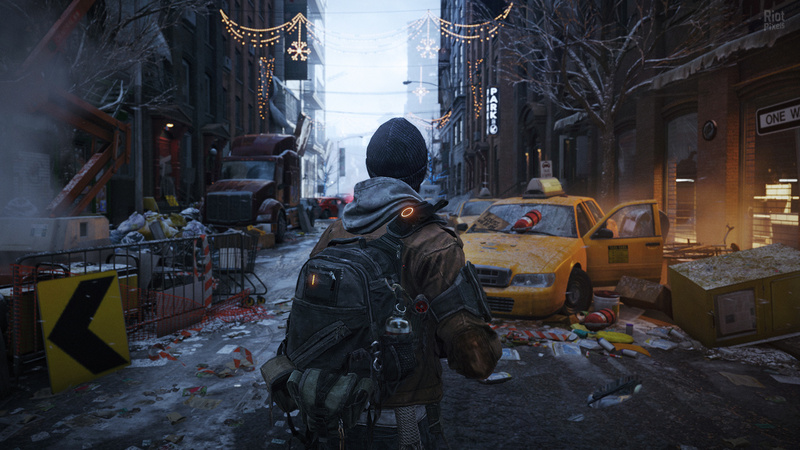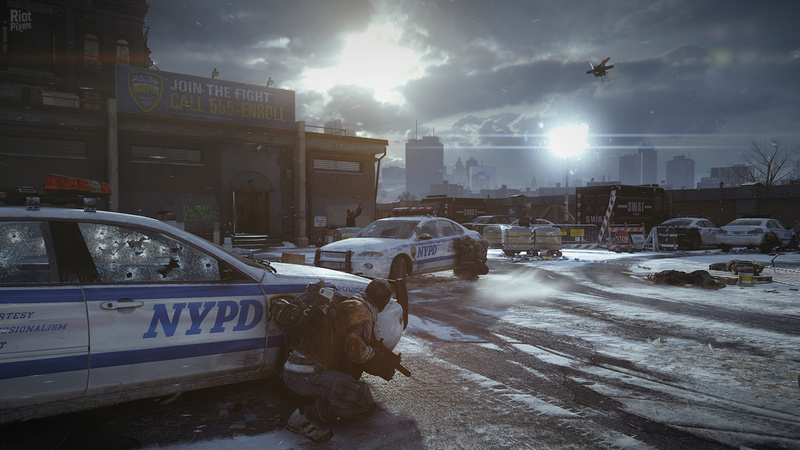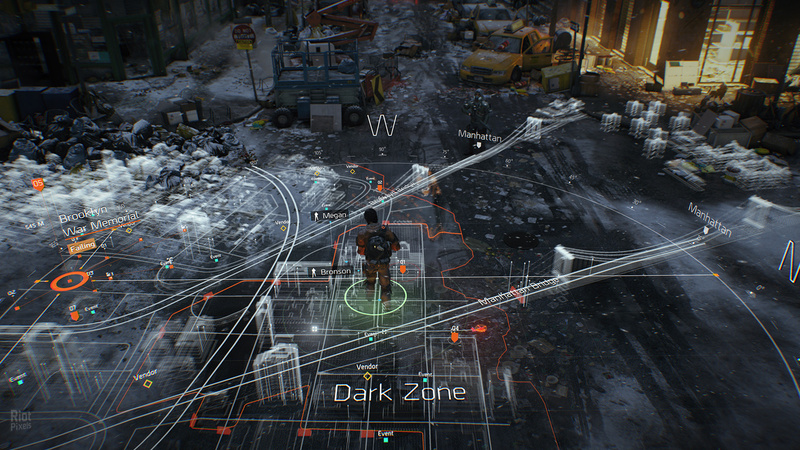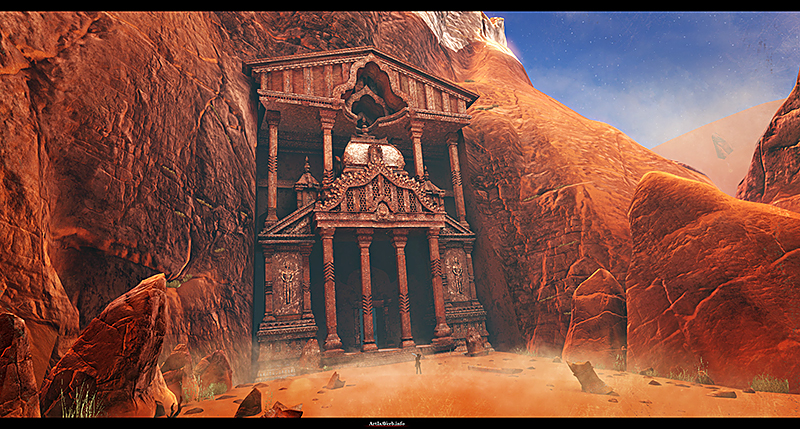“Did the texture kill the texture?” - thoughts about the role of textures, textures and materials in games

Not that I was a wild fan of consoles, but there are things that are really impressive. It is clear that the consoles of the new generation without impressive pilots on the market have nothing to do. This is not about Watch Dogs , which also deserves attention, like any open world sandbox, but about Tom Clancy's The Division announced for PS4 and Xbox One . The picture (I rate it only) looks really good. Games have long been trying to be non-games. This is almost a movie. I care a little now the question of the game-play of this game. Now I'm just a consumer who is ready to bite on a tasty wrapper.
In parallel with this, a skeptic developer wakes up in me, who never accepts anything on faith, who, before crying about the coming of something, first wants to make sure that the coming has happened. Not because it is afraid to look stupid, but because, having burned itself thousands of times, it does not want to repeat it in the thousand one and the first.
')
I have not been able to play games as a player for a long time. Have one hundred percent immersion. This is a side effect of the prism through which I look at any game. The eye first of all clings to familiar graphic artifacts, looking for ways that developers have gone in creating graphic content. Approvingly claps pluses, and frowns in distress where everything is left as it is, unchanged. All this is multiplied by the “artist's view”, which also applauds skillful actions, and roars indignantly in those places where an unknown artist made a mistake. All this is multiplied by the not-yet-finished gamer, who puts the game-play first.
A sophisticated cocktail that interferes with the full enjoyment of computer games. The fight of opposites. Internal conflict between consumer and developer.
What do I see here? First, look at the trailer and decide what you see for yourself. And then ... a shovel?

Behind the piles of network excitement around the new set-top box, I see the command rate on realistic lighting, desaturated pastel gamut (specifically for this project), cinematic effects, with well served gadgets like FOV and DOF , post-filters and insane, amazing imagination, number of decals (this is not a typo, but a term (see notes), as a means of enriching the picture.

All asphalt is strewn with small pieces of paper, scraps of newspapers, multi-colored specks. All this is decals (see attachments). Now the term decals has become much wider than at the time of its inception. Decal can also be considered a repeatable group of objects, combined into one, for example, a dozen different cans mixed with rolls of toilet paper and scraps of posters. Although in essence it was and remains the “object of saturation” (prefab (or static decoration object))
The chaos-stricken city, like the world of Fallout 3 in its time (developed on the Gamebryo engine and having a number of crutches (see appendices)) , is “crammed” with decals from and to. The entire horizontal level surface is teeming with sheets of paper, cans and rubbish. It looks great, rich. Immediately gives a sense of wealth. However, consoles have a limited power budget for PCs (to a large extent in terms of textures), and any console game developer must be proficient in their tools. Looking closer you can also see that the objects being cloned are basically low poly. Light touch of caution in the design.
In this bet on real-time lighting with good shadows, you can absolutely not cover the textures of objects, including compressing them to the limit, where appropriate. Even if one pixel of the texture falls on the geometry and gives it a color, the rest will be made up of light and shadow.
Light and shadow stretch anything. I came to this position a long time ago, and I have no reason to abandon this axiom. Thus, all objects that cannot be reached (conditionally speaking “upper head”) can be made geometry, filled with color, covered with light and shade, washed with post-filters, richly seasoning with smaller and more subtle geometry (wires, supporting structures, ropes , signs), posters and decals. That will give a complete illusion of wealth. It is not necessary to give a person wealth. You need to make him believe that he is rich. If you add a bunch of decal-based textures at the bottom of the levels, the player will simply go blind. What is happening.
After the light and the shadows (for which game developers have been fighting since the appearance of pseudo-three-dimensional games), the material of objects is on the agenda.

If you take a closer look and mentally cut the decals from the rest of the “landscape”, the volume of the “visual detail” will drop sharply. If you look twice, you can see that the objects are covered with neutral textures that have no explicit texture. The main work in the scene is done by volume (geometry), light and material of objects and special effects (reflections, rays of light, etc.). The quality of the picture of the game comes close to photography. On the right column are visible artifacts of the shadow map. It is possible that the release version, as often happens, will be much worse, due to the optimization.
Realism of materials provides for the presence of good shaders - A, and surface textures - B. If the designer imitates real materials, then it is enough to use hundreds of pure textures (uniform high resolution textures with the possibility of tiling in all directions), everything else will do the color (the texture color on the shader basis), multiplied by the light and shadow in the scene itself.
In any case, this is a good step towards photorealism. After all, “honest” walls and surfaces in our everyday reality look exactly like that. This texture "covered" lighting. Go to any wall. With a close look (and even without it) you will see the pores of the material. Like the pores of your skin. Relief multiplied by color and lighting.
Perhaps now, there is a new step in the industry. Perhaps it is here that designers will move away from the concept of “texture” - moving on to the concept of material and texture. But not to the fact that there are now on the basis of a dozen shaders of varying degrees of complexity and “detailed textures” imitating the surface of an object under close examination, but to the concept of Material and Texture - with large lowercase letters.
After all, the concept of material (shader) has existed for a long time, but the texture, in fact, is still not used. Globally. I'm not talking about normal maps, and I'm not talking about "detailed textures." The same material, exactly as the texture of the material, is represented in engines extremely poorly. There is some water, there are “shine”, for which, by the way, this or that engine is often criticized. This means that the user (player) has looked closely at the engine and the familiar shader determines the eye. Character Shader. Unreal. And this is not about unreal quality, but about bad performance. In the case of the Unreal Engine, and in particular in a number of kids from Id Software, this is “the very plastic shine!”.

As in the previous screenshots, you can clearly see how the materials work, how much they are moving the picture forward on the path to realism. To a greater extent, this concerns metal and plastic objects (surfaces with a high degree of reflection). Nevertheless, in dynamics it will be possible to see that not only they “work”.
The appearance of a new shader (as a new material in the arms race of realism) is still presented as something special. Something that promotes the owner of the next video card to a new level of visual perception. But we know that in essence, this is a “divorce”. One or two new shaders are added and a powerful PR begins, where we are trying to “stick” them like manna from heaven. Whereas in modeling packages, for example, all this has existed for a long time.
Yes, of course, now it's all in real time. This is a step forward. But not a revolution, as it is usually served. Just increased the power of technology, providing the ability to use what was static in real time. And this, in my opinion, is not yet a reason to trumpet about the revolution. Just one type of bolt or nut. Another half measure.
Although ... we know very well why this is happening and not otherwise. Marketing. Pieces of iron must be sold. Each product should have a beautiful and clear face with blue eyes. Another new blue eye, another series, another bag with a centner of bills.
Excluding the acidity of the last couple of paragraphs, behind the textures on the basis of textures - the future. Already, each “texture” may look and look like a bunch of the following components:
• Texture (diffuse map)
• Common color or mask of different colors (color map)
• surface shader (type of material)
• Decal
• Decal mask
• Reflected light (specular map)
• Reflected light mask (specular level map)
• reflection map
• reflection level map mask
• Terrain map (bump, normal or parallax)
• Mask of relief strength (level of ***)
• glow mask
All this is present and now in full (with more or fewer parameters, with these or other names), except that the Texture has not yet supplanted the Texture. This is not yet. But I also think that in triple-AAA projects, the Texture will very soon kill the Texture. Not today, and not tomorrow. Not immediately, but gradually. Like poison. And that in time will surrender its front. It will be pushed into the peripheral regions, where the production capacity is still lower (iPhones, iPads, portable consoles and other tomagochi)
The first explosions, heralding the beginning of yet another Last War out of thousands like it, have already begun. Perhaps we are already seeing them. It may be that this is only the lightning of a future thunderstorm. And, of course, I'm just a blind-minded alarmist. I do not exclude.
Nevertheless, something similar has already happened. With Normal Mapping technology. Indeed, at one time, 3D was so miserable that it was necessary to invent a transitional technology simulating the steepness of geometry, its volume and availability where it could not be due to limited production capacity. That was a revolution. This finally allowed the three-dimensional graphics to catch up with their older sister - two-dimensional graphics. So that there is no talk about the quality of three-dimensional graphics at the time of its inception, against the background of elaboration of two-dimensional graphics, it looked crippled. A promising cripple due to impending augmentation (yes, I know you did not ask for this).
Today, 3D has reached such a scale that it can be weighed not by kilograms, but by tons. Normal mapping is gradually becoming obsolete. The volume of geometry is steadily growing, moving the Normal mapping to the additional technology, but no longer carrying. Soon normal maps will become just the texture of leather, cement, wood.

If you pay attention to the pavement, you can see that it is unique. No repetitive pattern. The eye perceives it as real. This can be achieved in two ways. With several layers of decals, which is more economical, or with a Karmakovo mega-texture , when the level is created in the editor and where the artist simply works with a brush (using brushes, including geometric ones in the manner of sculpturing packages), and then the texture is baked into one, and cut for multiple fragments that are loaded as you move along the level (a very high level of exclusivity of each place in the game location)
The same will happen with photo textures. They are already reaching inconceivable sizes. But the future is not for photo-textures, but for photo-materials (with or without admixture of photos, it is not known where crazy progress will lead us). Since structurally, it is the original source material, not its photograph. Not his remark, reflecting only the perspective from one position. Material where everything will be counted. A multicomponent structure, parts of which will be made by completely different people. The above components of the material are similar to a snowball, which roll down from the mountain, overgrown with new and new "meat". And that moment is not far when the quantity will grow into quality.
Already in large offices there is a crushing on narrow-profile specializations. Game companies are real factories. But further, as in the case of the Invoice - everything will only get worse. Rather, it will only be Already. I meant more narrowly. From the standpoint of children's pants, which have become too narrow for a growing child.
The worker in our industry, conditionally, no longer makes the shoe, pants or jersey. He makes a cloth or “washer” (metal rings, into which the lacing is put) and passes a heavy mesh to the next section, clogged with shiny bagels. There they will be fitted to the fabric and transferred to the next department.
This is progress. It does not stop. Where there is mass production, there are always factories. There will always be a conveyor belt that does not provide for creativity, but provides bagels on a global scale. "Square Enix conducted a large-scale restructuring of its Russian branch, 14,300 people who were engaged in Q-bagels were laid off." And laughter, and sin, and fake. Excluding the number of "blanks", the number of employees, office, region and a fictional situation - this is almost a reality.
• The number of people in gaming offices is not so large, but significantly
• Companies regularly restructure (usually in the light of damages) and dismiss personnel
• Companies regularly restructure (at project completion and specific contractual work) and lay off staff
• The industry has not yet manufactured q-bagels, but it has long been a division into specialized employees. The term "wagon" frightens many more than pleases. And in vain. “A master of all hands” is a valuable property, most often in demand in small offices that do not seek to divide people into screws.
• Square Enix as far as I know has no representative offices in Russia. However, CryTek did not start here either, but its offices are now scattered throughout the world, including in Kiev and Budapest. Before us, as the saying goes, hand in hand ... really no need.
A few years ago I had acquaintances, whose whole activity was reduced to writing the text in the body of the shaders. Old-shader. Now the same familiar sliders in the material editors. They no longer model, do not draw concept art, do not offer ideas, do not conduct experiments. They are only small elements in a giant and growling gaming machine. Their daily activities - routine operations narrow profile.
I can do without slogans - “but indie will save everyone!” No one will save anyone, and never saved. Next to the giant factory there can always be a small shop of Chen, where you are used to buying "his noodles" and "his toys." This is your favorite seller with his small shop, and you are one of a thousand of his favorite customers.
You will always come to him because you love either the old, or - any something of a certain sort (which is, alas ... not released).
In time, you will grow old too. And someday the moment will come when Chen dies. You will come to this shop, and you will see that some busty blonde is changing Chen's display signs to advertise a product that increases hair growth on nipples (and the advanced Hair-Turbo-Pluss: Somewhere Edition will allow you to do it anywhere).
A kind of a bunch of hair, the color you want, which is very similar to a watercolor brush. It can be grown not only on the nipples, but in general wherever you want. “The hare with the navel” will no longer be a cartoon, but will be the brand of a new advanced technology for growing hair. “Do you want a navel anywhere?” Or “This clot will emphasize your individuality where you were even afraid to grow it” - it will become the slogan of the novelty.
Flapping with faded eyes, puzzled, you glance around the street and realize that you are hopelessly old, and a new world has grown up around you. It was. That's it. And so it will be.
For me, the point of no return was the screenshots and video of Tom Clancy's The Division. Today morning. I suddenly realized where everything was going. It seems like ... and so knew it. But I realized only now. Knowledge and awareness are two different things. Three years ago, I deliberately stopped my studies in technical disciplines, realizing that I no longer keep up with progress. That I cannot keep up with this arms race and the triumph of progress.
I took those tools that I have and went to do what I liked. I am Chen. A new world is growing around me. And I'm not afraid of that. This is just life. Progress. Growth. Birth and death. Evolution. It should be so. The main thing that I had you. Sometimes we went to my shop to buy something.
Applications
Texture - ( wiki wording ) bitmap image that is applied to the geometry in accordance with the UVW scan (texture coordinates). As a rule, multiple of a power of two. (8x8, 16x16, 32x32, 64x64, etc.) less often but also used textures in the form of a rectangle (16x256, 512x128). The texture can be any type of map (diffuse, specular, colored specular, normal, bump & etc.)
Detailed texture (detail texture) - A texture simulating a micro relief (repeated tile, for example, “pores of cement or concrete”), unlike normal maps and height maps, such relief is not sensitive to dynamic lighting. Nevertheless, the possibility of writing a shader where this microrelief will be made on the basis of normal maps is not excluded.
The texture ( wiki definition ) is the same as your hand. Personal micro-relief of each object makes it unique. It can be said that the object is unique and makes its features, but your fingerprint is a micro relief, your personal texture, your ID and your admission to the world where you, with rare exceptions, are truly unique. With all that it implies.
If you continue the analogy with your hand, then the pores and other micro-relief (warts, depressions, defects and scars) is an invoice. Skin color, age spots and moles are the texture. Part of the micro relief, to save textural space and cover you with skin tile, or “procedural skin,” plus moles and pigment spots can be applied with decals.
UVW scan - ( wiki 1 and wiki 2 ( eng. )) "Pattern" in the form of texture coordinates, which indicates where and how the texture is displayed. Muzzle Pekingese - the best example. Any sweep looks either as a pattern of clothes (a drawing where all the elements of future clothes are located) or as an object that was hit with a hammer. The formulation is quite voluntary, but I know from my own experience - it is not always interesting to read technical descriptions.
Decal (Decal) - Initially, decals were used to draw holes from bullets, blood stains or dirt (soot) from explosions. It was a sprite hole in concrete or metal (or any other object) with an alpha channel that was applied on top of the level geometry (or object). Subsequently, the decal has become an element of decoration. With its help, they began to apply moss, graffiti, mud drips, posters, etc.
In Half-Life 2, decals were applied in a blend mode similar to Overlay mode in Photoshop, which allowed to “burn through” the surface from the bottom, leading to a good visual effect of additional backlighting. In combination with HL2 brand light, it still serves as an example to light specialists. After the release of Dishonored, it became clear that the “light as in HL2” is not the merit of the engine, not a concept, but a person. Victor Antonov . And all this is primarily his merit as an art director, artist and chief ideologue of the style of this famous game.
Still later, the term “geometric decal” appeared where the decal principle was used, but instead there could be a whole group of objects (garbage, groups of small objects).
Shader - ( wiki-wording ) program that defines additional parameters of an object on the scene or texture. It is responsible for the absorption and scattering of light, the imposition of texture, reflection and refraction, dimming, glow, distortion of texture information in accordance with the algorithm described by the programmer (or old shader).
Post filter. A shader-based filter that can affect either the entire screen as a whole, or its individual zones marked by “gender” (enhancing the brightest areas of the screen, blurring the bright areas of the screen, distorting certain colors, etc.)
Gamebryo engine. The developers are like one who is very public, who is more quiet, but ... almost unanimously consider Gamebryo to be a buggy and not very convenient toolkit. From the very first problems that come to mind, the following can be identified:
• An inconvenient scripting language
• Lack of shadows
• Problems with animation
• A buggy physics engine
But this does not deny the fact that a number of iconic games were made on this engine. In general, I want to note again (I do this in each publication). What is important is not a tool, but a hand holding it. And that's all. Point.All disputes must end in this position. Because a good hand and a bad tool will make candy (which happens very often), and a bad hand can hinder various appendages. Well ... and growth. Another indisputable fact - hands must grow from the right places.
Backdating notes
: , . « » ' «». . « ».
: , . , «». -, — .
: ( ). X-BoX PS ( ), . – « ».
: , PlayStation «» , , . , . . . , , (. ).
: .
: Riot Pixels
: ( ) UVW , . - , — . - . , .
Then, hot on the heels, Denis Udalov wrote to me and, alas, damn it, I saw this post much later than I should have. So Denis kindly suggested that I take a look at the scene that was created without the use of diffuse textures by Andrey Maximov . It uses procedural textures, normal elevation maps, elevation maps, etc. Just what I talked about in my little post. But better ... just take a look. ( link to the material provided )
Scene Sample:

This is only a part of the approach that can be used in the future. With power, all the sculptures could have been made not with normal maps, but with geometry. And so on and so forth. Agree that taking a sculpture in the engine and assigning it procedural material is much easier than making a high-poly model, low-poly for it, scanning for low-poly (or mid-poly), counting the normal map, making diffuse textures, maps speculators and stuff. Is not it so?
I am confident that in the future progress will come to this. The truth is that it “delays” (leaves without a soul) many design elements where only the artist’s hand can breathe life into the element, giving it its own special charm and style.
Source: https://habr.com/ru/post/182958/
All Articles